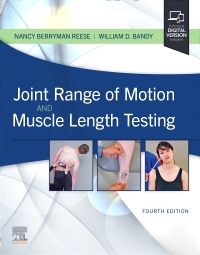Joint Range of Motion & Muscle Length Testing, 4th ed.
| Ò | : N.B.Reese & W.D.Bandy |
|---|---|
| oÅÐ | : ELSEVIER |
| ISBN | : 978-0-323-83187-1 |
| y[W | : 645pp. |
| oÅN | : 2024N |
ÝÉ
è¿20,317~({Ì18,470~ { Å)
¦ÝÉ\¦uȵv̤iÍCOÉĶð³èÜ·BTË4`6TÔÅæñÂ\Å·iuߧv̤iͧsãÌü×EÉÈèÜ·jB
ȨACOãÌLZͨó¯Å«©ËÜ·ÌŲ¹³¾³¢B
- ¤ià¾

Gain the skills you need to accurately measure joint range of motion and muscle length! Joint Range of Motion and Muscle Length Testing, 4th Edition provides a comprehensive guide to the techniques and devices used in measuring range of motion for the joints of the spine and extremities. Clear, step-by-step instructions show how to make reliable measurements with instruments such as the goniometer, inclinometer, tape measure, and even smartphone apps. Written by noted educators Nancy Berryman Reese and William D. Bandy for physical therapy and occupational therapy students, this manual includes a fully searchable eBook version with each print purchase.
New to this edition
NEW! Instructions for use of smartphone apps provide another option for measuring range of motion.
NEW! Revised content and updated references provide the current information you need to be an effective practitioner.
NEW! eBook version is included with print purchase. The eBook includes more than 100 videos demonstrating the ROM and muscle length testing techniques discussed in the print book, and allows you to access all of the text, figures, and references, with the ability to search, customize your content, make notes and highlights, and have content read aloud.
Key Features
Guidelines to range of motion and muscle length testing cover techniques including goniometric measurement as well as measurements using inclinometers, tape measures, and smartphone apps.
More than 600 full-color photos and drawings demonstrate various techniques, anatomy, and landmarks for each joint.
Anatomical landmarks provide a fast visual reference showing exactly where to place measuring devices.
Clear template for techniques allows you to quickly and easily identify the information you need.
Chapters on length testing make it easy to locate information on measuring each of the upper and lower extremities as well as the head, neck, and trunk.

![®ïÐ ì]° / NANKODO](/img/usr/common/logo.gif)



